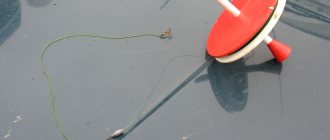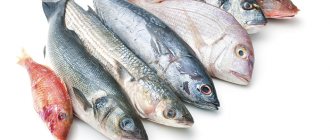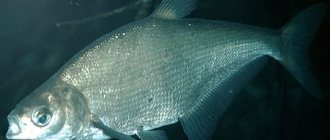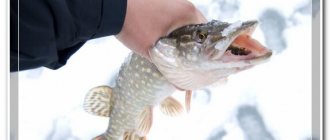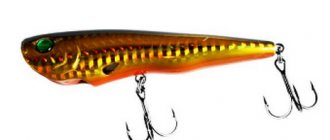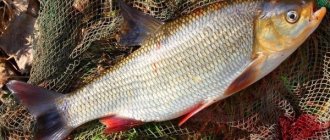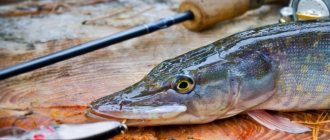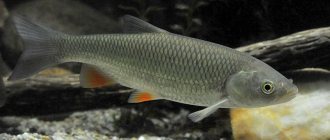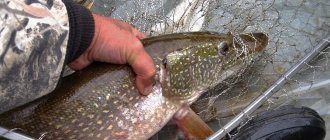What does a pike look like?
Pike is considered the most voracious predator of the country's water bodies. She leads a secretive, sedentary lifestyle. Tends to hunt prey at close range from an ambush, guarding future food while in cover. But during the period of active feeding, the fish changes tactics, moves around its grounds, and when it sees a target, it attacks and aggressively pursues it.
The structure of fish and its features
It is easy to recognize a pike: it has an elongated body, almost cylindrical in shape. Due to this structure and the presence of single fins attached to the tail, the fish is capable of developing lightning speed.
The plumage is well developed, characterized by a paddle-shaped or rounded shape, which also has a positive effect on the hydrodynamics of the pike. The scales fit tightly to each other, forming a dense monolithic cover throughout the body - this helps protect the fish from the sharp teeth of predators or relatives.
Mouth, vision and sense organs
The fish has a flattened, wedge-shaped snout, which allows the pike to see frontally - this helps it assess the speed of moving fish and the distance to them. This structural feature of the skull and high-set eyes give the pike the opportunity to view the water area not only above it, but also from the side, and also see objects below it.
But due to the wide open mouth, the angle of view below itself is significantly reduced, which does not allow the fish to see the target up close if it is below it. Anglers who are aware of this feature try not to push their baits to the bottom.
The predator has excellent hearing, thanks to which it is able to go hunting even in muddy water, picking up the source of the slightest vibrations in the water from a great distance. Pike has a wide and elongated snout, which has a significant gripping area, and the peculiarity of the structure of the gill membranes, separated from each other, does not make it difficult for the fish to open its mouth wide to catch large fish.
Teeth and their replacement
In the mouth of the predator there is a huge number of sharp teeth, some of which are located on the jaws and consist of fangs of different sizes. On the tongue and palate, bristle teeth are visible, which represent a fleecy cover of needle-like formations, reminiscent of the bristles of toothbrushes.
Interestingly, the pike does not chew its prey with its teeth; it needs them to hold onto it. The main weapon of a fish is its teeth, because with them it can cause serious injuries to inexperienced fishermen who do not know how to handle it.
Another feature of the fish is the replacement of old and damaged teeth. Some believe that this happens after spawning on a full moon. The change of teeth in pikes is not periodic, but constant. When changing teeth, the fish continues to feed, which means it can be successfully caught. The absence of a bite immediately after spawning indicates a loss of strength in the exhausted fish after reproduction, but not a change in teeth.
Color
Pike is distinguished by its camouflage color, which allows it to remain unnoticed anywhere in the reservoir. The fish has light transverse stripes and spots in the form of a camouflage pattern throughout almost the entire body, except for the belly. This is especially good for fish in places where there is a lot of dense vegetation and snags.
It is very difficult to accurately answer which color is considered to be background and which belongs to the picture. The tone depends on the age of the fish, habitat, nutrition and other factors. Juveniles have a lighter coloration, which becomes darker as the fish matures. The most common color, characteristic of many fish, is gray-green with olive stripes and spots. Usually the fish has a dark back, a light yellow or gray-white belly with gray specks, and gray fins with light streaks and stripes.
How does pike hunt?
Due to the cannibalism inherent in pikes, pikes cannot live in a school and lead an exclusively solitary lifestyle. Only during spawning can pikes stay in small groups of 4-5 individuals.
Pike is an ambush predator. The pike stays in thickets of aquatic vegetation, near snags, while it hides and stands absolutely motionless, making swift, lightning-fast throws at small fish swimming past. For ambush, the pike chooses shallow grassy places, thickets of reeds, and snags.

Small and medium-sized pike choose thickets of reeds, cattails and other aquatic vegetation for ambush. Large pike try to stay in the depths, choosing an ambush site in the form of a snag or a flooded bush.
During its hunt, the pike uses not only vision, but also the lateral line organ, which is located not only along the pike’s body, but also on the head. Especially many lateral line sensors are located on the anterior part of the lower jaw.

During the zhora period, the pike changes its hunting tactics; instead of passively standing in ambush, it begins to actively patrol its hunting grounds and, having discovered potential prey, aggressively pursues and attacks it.
In the winter season, pike activity decreases, it hunts less and feeds much less often.
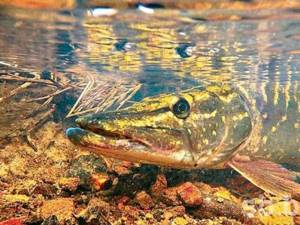
On clear, warm, sunny days, pike swim up to the very shore, stick their dark backs up and stand motionless for a long time, basking in the sun. Large pikes do not come so close to the shore, but they also float to the surface, somewhere in the grass thickets. If a fisherman, moving along the shore, scares off pikes basking in the sun, they dive with a loud splash and move away from the shore, but do not move far from their favorite place.
Varieties of pike
Pike is a large fish, numbering seven varieties. These include common, American, Amur, black, southern, Aquitanian pike and musky fish.
Ordinary
A typical representative of the genus. Inhabits many freshwater bodies of Eurasian and North American countries. The body length reaches 1.5 meters with an average weight of 8 kilograms. The color of the common pike varies depending on its habitat. There are gray-green specimens, individuals with a brown color and gray-yellowish fish.
The common pike prefers to settle in thickets, stagnant waters, and the coastal part of the reservoir.
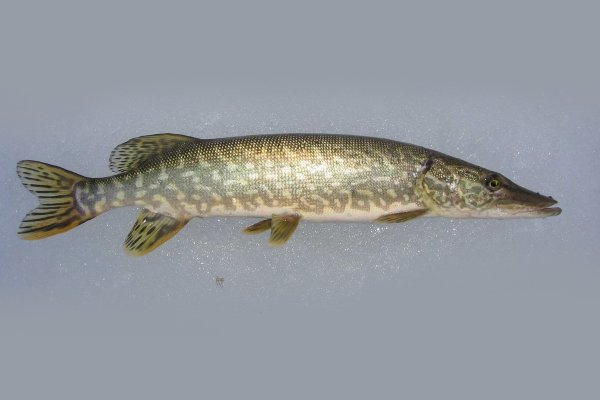
American
This is a redfin pike that lives only in eastern North America. It is divided into two subspecies: the northern redfin pike and the southern redfin pike, found in the Mississippi and waterways flowing into the Atlantic Ocean.
Not a single subspecies of American pike is large in size. They grow up to 35-40 centimeters in length and reach a weight of 1 kilogram. A distinctive feature is the shortened snout. Southern pike do not have red fins. The lifespan of American pike is no more than 10 years.
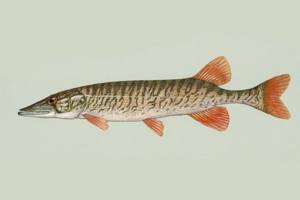
Muskinong
The largest species of pike, considered a rare species. The fish was given its name by the Indians, who called it maashkinoozhe, which means “ugly pike.” The fish received its second name “giant pike” due to its impressive size. Some individuals can reach a weight of up to 32 kilograms with a body length of up to 1.8 meters. A distinctive feature of pike is its silver, green or brownish-brown body color. There are spots or vertical stripes on the back.
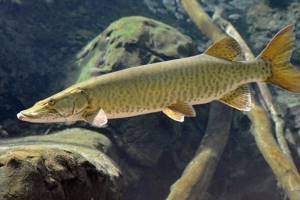
Amurskaya
Fish with small silvery or golden-greenish scales. The color of the Amur pike is interesting - numerous black-brown spots are scattered throughout the body, from head to tail.
Representatives of this species grow up to 1.15 meters, reaching a weight of up to 20 kilograms. The Amur pike lives in the reservoirs of Sakhalin Island and in the Amur River. Life expectancy is up to 14 years.
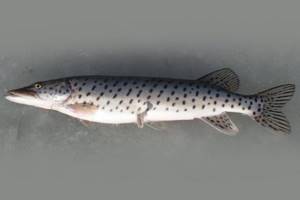
South
Previously, the southern pike was considered a subspecies of the common pike. The species was first identified in 2011. The fish lives in the reservoirs of Central and Northern Italy.
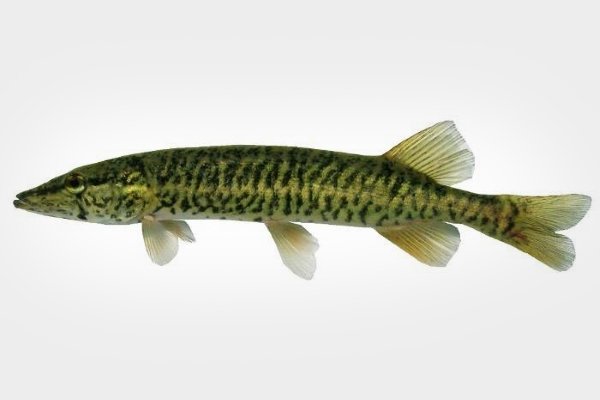
Black
A predator that lives in North America, inhabiting lakes and overgrown rivers from the southern shores of Canada to the state of Florida in the USA and further to the Great Lakes and Mississippi valleys. The body length of adult individuals reaches up to 60 centimeters and weighs 2 kilograms. Externally, black pike is similar to the common species. A characteristic difference is a mosaic pattern on the sides and a dark stripe above the eyes.
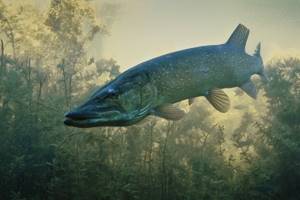
Aquitaine
A young species that was first described in 2014. The habitat of the Aquitaine pike is France, where the fish inhabits almost all bodies of water.
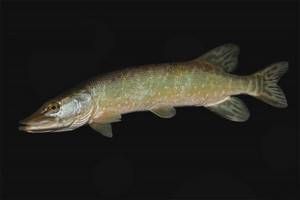
Description
Pike is a genus of freshwater fish, the only one in the pike family.
Pike can reach 1.5 m in length and weigh up to 35 kg (usually up to 1 m and 8 kg). The body is torpedo-shaped, the head is large, the mouth is wide. The color is variable, depending on the environment: depending on the nature and degree of development of the vegetation, it can be gray-greenish, gray-yellowish, gray-brown, the back is darker, the sides have large brown or olive spots that form transverse stripes. Unpaired fins are yellowish-gray, brown with dark spots; paired ones - orange. Silver pike are found in some lakes. The lifespan of individual individuals can reach up to 30 years. Pike are extremely voracious predators. They feed mainly on fish (roaches, perches, minnows). Most often, the length of pike is up to 1 m (occasionally up to 1.5 m), weight up to 8-12 kg (occasionally up to 35 kg). The body is elongated, arrow-shaped, with a large head and a wide mouth, studded with numerous sharp teeth slightly directed inward. The gill membranes are not attached to the interbranchial space. The dorsal and anal fins are set far back. The dorsal fin has 5-9 unbranched and 12-16 branched rays, and the anal fin has 4-8 and 10-15, respectively. The scales are small, thin (in the lateral line, located above the middle of the body, from 116 to 144 scales).
The body color of the pike is spotted, dark stripes are located across the body. Depending on living conditions, it may have a gray-greenish, gray-yellowish or gray-brownish tint. The back is usually dark, the belly is whitish with gray speckles. The dorsal, anal and caudal fins are brownish with black spots, the pectoral and ventral fins are yellowish-red. The overall color of pike is subject to significant changes depending on age and time of year (with age, for example, its color becomes darker). Pike that live in silted lakes with muddy water have a dark color.
Where does the predator live?
Pike inhabits fresh water bodies of North America and Eurasia. Usually the fish hides in low-flowing or stagnant waters, coastal areas, and thickets. The fish leads a sedentary life in lakes, rivers, and ponds. But pike are often found in partially desalinated areas of the seas, for example, in the Curonian, Finnish and Riga bays of the Baltic Sea.
In lakes and ponds, the predator swims close to the shore, remaining in littered shallow water with thickets of algae. In rivers, fish are found not only near the coast, but also at depth. It is preferable for pike to live in the mouths of rivers flowing into large reservoirs.
Pike feels comfortable in those reservoirs where there is sufficient oxygen content, because even with a winter drop in the water level, the predator can die. The fish tolerates acidified water very well, which is why it is often found even in swamps. The fish tries to avoid fast and rocky rivers.
The main condition for the presence of fish is the presence of abundant vegetation. In the northern regions, fish often hide behind stones, under bushes or snags - there they wait for their prey.
In an ambush, the fish remains motionless, after which it rushes sharply and quickly towards its target. It is rarely possible to cope with the death grip of a pike; if it chases prey, it will not be possible to escape. The peculiarity of this fish is the ability to make high jumps in the air, and it is also capable of swallowing a victim only from the head.
Pike lifestyle
The choice of habitat is largely determined by the sedentary lifestyle of the predator. Thickets of pond vegetation are an excellent place to wait for their prey. Most of the time, the pike simply stands motionless, but when it spots a prey, it accelerates and attacks with lightning speed. It is noteworthy that no matter from which side the pike captures its prey, it always swallows it from the head, first turning it around if necessary.
Even large adult individuals choose shallow water to live. There are cases in history when very large specimens were caught at a depth of only 40-50 cm. A prerequisite for a long life for pikes is an abundance of oxygen in the water, which is why pikes die in shallow bodies of water, especially in winter.
Pike always waits for its prey where there is cover. Even large individuals living at depth will definitely find algae or snags to hide behind. On sunny days, fish go out into shallow water to bask in the rays of the sun.
Pike tolerates proximity to other individuals; they hunt in turns: while one is digesting food, the others are in ambush. Adults prefer solitude, gradually eliminating their smaller counterparts from the area of the reservoir. The large pike has practically no enemies, with the exception of humans, so in fresh water bodies it rightfully feels like a queen.
What do fish eat?
Pike fry prefer microorganisms that are in the water. But as the fish grows, it begins to feast on the fry of smaller fish. The diet of adults consists exclusively of fish. The most attractive to predators are small live fish, including crucian carp, roach, bleak, rudd, perch and fish of the carp family. Fears unfamiliar fish.
Pike eat 3-4 times a year, usually before spawning, after spawning, in May-July, and in September-October.
These dates are considered conditional, because a lot depends on weather conditions.
How does pike grow and how many years does it live?
It would seem that the predator is invulnerable and can easily live for decades. But it's not that simple. Pike, like any other fish, is subject to catch and attack by other predators, such as otters.
Its eggs, which it lays in early spring, are readily eaten by migratory birds. Young pike are attacked by their relatives, who are larger and stronger. Those pikes that have managed to mature often become ill with various diseases or die from poor environmental conditions. Well, how many years does a mature and adult pike live?
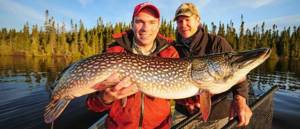
Spawning and offspring
Pike spawn at a temperature of 3-6 degrees, immediately after the ice begins to melt, at a depth of 15 to 1000 meters (depending on the area). During spawning, pike swims into shallow water and splashes noisily. In natural reservoirs, males reach puberty at 4 years of age, females at 5 years of age.
Typically, reproduction begins with the smallest individuals, after which it is time for the larger individuals to spawn. At this time, pikes stay in groups, 2-4 males per female, and up to 8 males among large females. The female pike swims in front for spawning, followed by the males on the side. During the breeding season, fish begin to rub against bushes, stumps, reed stems, cattails and other objects. The fish do not stay in one place for a long time, they constantly move around the spawning area, spawning.
If after breeding the water quickly subsides, mass death of eggs occurs. This phenomenon often occurs during spring drawdown (reset) of the level in reservoirs.
Reaching a length of 12-15 millimeters, pike fry are already capable of independently hunting for the larvae of carp fish. Typically, fish of the carp family spawn after pikes, thanks to which pike juveniles manage to become significantly satiated. After individuals reach a size of 5 centimeters, they completely switch to feeding on the young of other fish.
In the spring, pike, along with flood waters, settle in floodplain lakes. After some time, the connection between lakes and rivers is interrupted, which is why the lifestyle of such pike differs significantly from the life of relatives living in rivers or large reservoirs. Lack of nutrition leads to the fact that individuals of the same age can be 2-2.5 times smaller in size. Small fish become prey for larger predators.
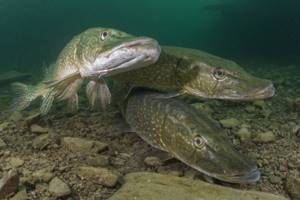
Vision and other senses
Pike has excellent eyesight and is able to spot prey from a long distance. The viewing angle of the eyes is wide, thanks to this it monitors prey located on any side.
The predator distinguishes colors and is able to change the shade of its own body depending on the surrounding background. Fishermen have long been using pike's love of certain colors for their personal interests. Most of all, the toothy one loves colors that remind it of a natural fish. These are the baits that are often used by spinning fishermen. In addition, you can seduce the toothy one with bright red or yellow shades. The fact is that bright colors arouse her banal interest, and also provoke a predator. Lures of these colors often work in cloudy weather.
But to a greater extent, when hunting, pike rely on the lateral line. This is a special sensory organ of fish that allows them to sense vibration. The movements made by a fish swimming past become a source of vibration to which the predator reacts.
When hunting, pike also rely on their sense of smell. True, this sense organ is far from in first place. Sometimes the predator spits out the artificial bait immediately after grabbing it. This is partly explained by the fact that such an imitation does not smell like real fish. But even if the artificial bait has a natural smell, the attack occurs more often. It is for this reason that spinners often put pieces of fresh fish on the tee of their spinners.
Recommended reading: What do trout bite on?
Uses pike and hearing. Quite often, an attack occurs instantly, after splashing down the bait. In this case, the freshwater torpedo is guided by the splash.
Pike fishing
Pike fishing is a varied activity where various baits and methods are successfully used. When pike are caught with a spinning rod from the shore or from a spit, spoons, mainly spinners, are often used.
Seasonality
Every fisherman knows that pike is a solitary fish that prefers bodies of water with weak currents; it lives near vegetation and settles in holes and snags. From the first days, pike fry begin to actively hunt. By the end of the first year of life, the young reach up to 40 centimeters in length and weigh up to 1 kilogram.
In large lakes, about several dozen individuals are caught in one season; their length is up to 1 meter and their weight is up to 15 kilograms. The best time to fish is in spring and fall.
In spring , pike begin to reproduce. During this period, its fishing is prohibited. After spawning, she begins to eat, which helps to restore strength. The fish, hungry during the winter, rush at everything that comes into their field of vision and take any bait. In spring, pike usually bite during daylight hours; at night, the fish sleep. Shallows and coastal vegetation are considered fishing spots. Fishermen achieve especially good results on warm, cloudy days.
In the autumn , when the “hungry” months are approaching, the fish begins to stock up on fat. In autumn, the bite is not so intense, and the pike stays at the depth where small fish go for the winter, but the fishing is much more interesting, especially since during the summer the pike gain weight, are energetic and active in resistance. The meat of such fish is considered very tasty.
In summer , pike bite inconsistently, and if they take the bait, it is extremely unreliable, and often clings only with the lower lip at the very edge and often comes off the hook. The best time for fishing is the beginning of noon and until 16:00 in the evening.
In summer, predators move to thickets of water lilies, lotus and water chestnut, due to the fact that there are many small fish and duck broods. During this period, huge pikes weighing 10-15 kilograms are visible almost in the shallows. If you throw a spoon or wobbler correctly, you will be able to catch a large specimen.
Spinning fishing
It is good to use both oscillating and spinning spoons for pike fishing. But the fisherman needs to know that spinning ones sink more slowly and are preferable to use in fast currents and in the grass.
Wobblers are synthetic fish that imitate the behavior of fry. They are divided into floating and sinking. Swimming fish are used to catch pike in the upper layers of water - no more than 2 meters; sinking fish are quickly lowered to depth. The optimal size of a wobbler is considered to be 7-12 centimeters. It is permissible to take 4-6 centimeters, but then the likelihood of catching a trophy specimen is significantly reduced.
Fishing
Pike are caught using a landing net or hook. If you manage to catch the first pike and do not have these devices at hand, you should not grab the prey with your hands - the pike will not only escape, but also injure your hands.
The most reliable way to fish a pike out of the water with your bare hands is to bring the fish to the shore, press on the eyes of the pike with your thumb and forefinger, and calmly pull the fish out of the water. You can avoid injury only by removing the bait from the fish’s mouth using an extractor. They open the mouth of the pike with a gaper.
How to catch a trophy pike?
Big fishing requires careful preparation and adjustment. First of all, big pike like big bait. Silicone monsters up to 25 centimeters long are considered more successful baits for catching fish. Small fish will not swim up to such a “monster,” but individuals weighing 7-8 kilograms will definitely attack. They catch trophy pike on a motor boat, dragging several baits behind them, at a slow speed.
A peculiarity of predatory fish is that after an unsuccessful hooking, the fish will not hide in the depths and will not swim far; on the contrary, it will return to its stopping place. Due to this, it is necessary to repeatedly fish potential places where pike can sit in ambush. It is important to know that pike will never go on a long chase, but from 10 meters it can take risks. Fishermen noted that sometimes the pike jumped out of the water in an attempt to catch the departing bait.
Maximum size and lifespan
The maximum length of pike reaches one and a half meters. In this case, the weight can reach up to 30 kg. But more often there are individuals up to 1 m 30 cm long and weighing up to 15 kg. Pike lives on average up to 20-25 years. Of course, in some old fishing books you can find information about simply amazing specimens over 200 years old. But this data is rather a myth and should not be taken seriously.
We recommend reading: Taimen fish, description
By the end of the first year of life, the pike has a length of 15 - 25 cm. Size and weight directly depend on the habitat. The presence of a good food supply has a positive effect on the growth rate of fish. The same can be said about the appropriate temperature. Therefore, in the southern regions it grows much faster than in the northern regions. Reaches sexual maturity in the third year of life. At this point, its length ranges from 32 to 41 cm. In the tenth year of life, the pike usually reaches the mark of 1 meter. From this moment on it is considered a truly trophy specimen.
Useful properties of pike
The main advantage of pike is that it has dietary properties due to its low calorie content and minimal fat content. Pike meat is also rich in powerful natural antiseptics, which not only strengthen the immune system, but also help resist bacterial infections. Because of this, consumption of pike meat is recommended for the prevention of influenza.
Pike contains phosphorus and potassium, B vitamins and other substances - its regular consumption helps reduce the risk of heart arrhythmia. Pike is very useful for people who have cardiovascular diseases, problems with the gastrointestinal tract, obesity, and hypovitaminosis.
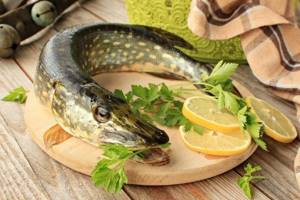
Eyes and body of a pike
If we consider the description of this type of eukaryote, then it is worth starting with an unusual elongated body with contours similar to a torpedo, flat sides, with a large protruding head, with a slightly flattened mouth located on it, occupying half of the head.
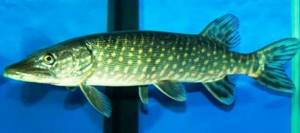
You can pay attention to the enlarged part of the lower jaw, complementing the fused cranial bones, which are distinguished by mobility in the area of the posterior ocular vertical. The structural features of the oral cavity are used by fishing tackle manufacturers. To catch this type of eukaryote, a special float is made.
The presence of a well-developed jaw and teeth of different sizes, as well as the presence of small, sharp teeth in other parts of the oral cavity, including the pharynx area, intended for small food - this is the main difference between predatory fish. The presence of such a useful function as the displacement of a tooth in place of a fallen one significantly increases the chances of a predator in a hunt. Since the gills are not attached to the interbranchial space by membranes, this allows them to swallow large prey.
This type of eukaryote completely lacks an adipose fin. All fins have a rounded shape, the smallest of which are located on the stomach and chest area. In the upper part of the body, on the lateral line, there are about 105-144 scales concentrated.
Few freshwater fish are as popular among anglers as pike.
This commercial fish has tasty and at the same time dietary meat, which makes pike in demand. And knowing the fishing technique and choosing the right bait, it’s possible to get a wonderful trophy. Article on the topic: Cranks for pike
Do they breed and raise pike?
Pike is a predatory fish, and for this reason it should not be bred in ponds where carp or trout are raised. But fish perform well in natural lakes, ponds and rivers, where there are a lot of trash fish, which will be the basis of the diet.
Many entrepreneurs are engaged in successful breeding of pike in lakes with shores abundantly overgrown with vegetation. In such places there are always a lot of small fish, and here it will be easy for pike to catch prey. But in reservoirs with poor vegetation, where there are few forage fish, one cannot dream of successfully breeding pike, because from hunger it is prone to eating small relatives.
When artificially bred, pike are able to gain weight much faster than in natural conditions. If there is an abundance of forage fish, pike fingerlings weigh on average about 400 grams, and individual specimens sometimes weigh up to 1 kilogram.
Features of growing fish:
- Breeding fingerlings are raised in feeding ponds along with carp. The next year, most fish farmers keep only replacement young stock, and the rest of the stock is sent for sale. Fish that are 2 years old are raised in carp brood ponds, where they will feed on carp fry and weed crucian carp. In winter, pikes are sent to earthen cages, where 15-20 fingerlings of crucian carp or roach are planted with them per 1 pike.
- If a fishery does not have its own broodstock, pike from natural reservoirs are used to obtain young stock. Due to physiological characteristics, at least five males are taken per female. Earthen cages or small ponds where there is abundant bottom vegetation are suitable for breeding - spawning is possible only on this.
- Already on the third day, pike larvae are caught from the cages. No later than 15 days after hatching, the larvae are sent to feeding reservoirs, where they will be able to find food for themselves. To ensure that the larvae do not remain on underwater vegetation during the process of being caught from the spawning ground, it is first removed.
Raising pike in ponds is a troublesome task; it is preferable to use special devices in which the eggs are inseminated and the further artificial incubation process takes place.
In feeding reservoirs, the survival rate of young animals is on average about 50%. For one hectare of pond where there is a lot of weed fish, there are no more than 400 pike individuals, where there are few of them - no more than 250. But where there are no weed fish at all, up to 120 fry are released. In large reservoirs there are 300 pike fry per 1 hectare of water surface. In this case, reservoirs must be drained once every 2 years.
Pike habitats
The predator's habitats are freshwater bodies of water, mainly in the northern parts of the Eurasian continent and North America. Pike is found in stagnant water or rivers with weak currents, in coastal areas overgrown with vegetation. The predator is found in the freshwater bays of the Black, Baltic, Caspian, Azov and Aral Seas.
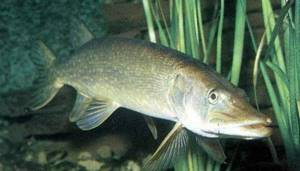
Knowing the habitat and habits of a predator, you can count on a good catch. It is better to fish in early spring, when the temperature is warm, but before the first floods, usually in March-April. The optimal place for fishing will be a small river after spawning, because 7-12 days after spawning in the spring the fish are especially hungry. Pike usually spawns as soon as the ice melts and the water warms up to 3-5°C, at a depth of no more than a meter. This is the only time when she gathers in a flock.
The predator, hungry during the winter, is indiscriminate in its choice of food and will bite on any bait. This period of time is usually short-term, not exceeding 12 days, so it’s better to hurry up, because the river predator will not sit still for long and go after new prey.
Interesting Facts
The largest pike that was ever caught is the fish that Emperor Frederick II Barbaross personally caught in 1230 in the city of Helboron. At that time, the length of the fish was slightly less than 3 meters, and its weight reached more than 70 kilograms. The fish were ringed and released back into the lake. After 267 years, this fish was caught in the same lake, but its length had already reached 5.7 meters and its weight was 140 kilograms. Due to its long life, the pike acquired a completely white color. The fish was released again, but no one else saw it.
Another interesting fact is that over the course of a long life, fish gain experience, grow, and look for larger prey. They are able to feast on small ducks, muskrats and other waterfowl. Individuals reaching a length of more than 2 meters can also feed on larger mammals, for example, dogs, or when reaching a length of 5 meters, attack a person (such cases are unknown, but quite real).
Pike is a large predatory fish that can be bred in your own pond. They make quite a good profit from retail sales, because fish meat is highly valued due to its rich composition, low calorie content, and beneficial effects on the human body.
0
0
Copy link
Maximum weight of pike
Fishermen create a huge number of legends, fables and tales about giant fish. According to one of these legends, the largest pike was caught in Germany. Its mass was 140 kg and its length was 5.7 m. However, this story is not supported by any facts.
In the world
One cold October day in 1986 in Germany, fisherman Louis Lothar pulled a huge specimen weighing 25 kg from Lake Griffin. At that time, this was a record; it was even included in the Guinness Book. He later gave interviews to famous magazines that were interested in his catch. The fisherman said that he did not even think that such large pike could be found in Lake Griffin. She fell for live bait. Louis even suffered while pulling his find out of the water; it bit his hands.
Also on the list of the largest fish is a pike caught in Switzerland by fisherman Akom Nilsson. The catch weighed 21 kg. The fish was caught with a spoon. The lucky one could not free the predator for a long time; there was a struggle for 15 minutes. But the man gathered his strength and the pike gave up.
About
Pike breeding
Depending on the type of pike, in a natural reservoir females can reach sexual maturity with a body length of 300 mm, and males 200 mm.
Pike spawning: how many times a year and at what time?
The predator spawns once a year, in early spring, at a water temperature of 60. This occurs in flooded meadows, immediately after the reservoir is freed from ice. Pike go to areas up to 1 m deep and rub against plants. Young females and males emerge first, then they are replaced by experienced breeders.
During this period, pikes move in small groups. One small female is “served” by 4 or 5 males. 7 males fertilize the eggs of large pike at once. At this time, you can see the protruding fins of the female in front and the males clinging to her. The fish is constantly in motion, the female rubs against the plants and lays eggs on them, the males release milk and fertilize future offspring.
After the female has laid all her eggs, the group noisily breaks up, going in different directions. During spawning, each female lays at least 17,000 eggs. But large individuals can produce 210,000 embryos. Eggs up to 3 mm in size stick weakly to plants and easily fall to the bottom after a few days. After 2 weeks the larvae appear. If the water temperature is between 5–100. After 6 days, the yolk sac completely resolves and the fry appear. Already at this age, the essence of future predators is visible - at this time, the fry actively eat eggs and larvae.
What does a pike fry look like and what is it called?
When a pike fry reaches a size of 12–15 mm, it begins to actively hunt for bloodworms, all kinds of crustaceans and small fish. He does not disdain weakened relatives. But it itself can become food for adult pike and perch.
In nature, no more than 5% of embryos survive to the period of active development and nutrition. Fishermen call the small predator a pike, a small-mouthed fish, or simply a lace.
Pike biology
Having learned this information, you can understand why there are periods of no biting, although the statement that the pike does not hunt during teeth replacement is very controversial. But we'll talk about this later.
Pike scales - evolution, functions
In fish, scales began to appear during the period of evolution and replacement of the bony shell. This process began 50 million years ago. In all species of pike, except for the armored one and several of its subspecies, the shell has completely disappeared.
This property is especially important for pike when attacking. The scales allow you to move faster - this is due to the flexibility of the body and the elasticity of the entire layer of scales. Moreover, the mucus secreted on the scales significantly reduces the friction of the fish’s body when moving and serves as protection against certain types of bacteria and diseases.
How many teeth does a pike have and when does it replace them?
Both of these questions are incorrect. Let's explain why:
- The teeth of a predator cannot be counted. They are located along the entire plane of the mouth and even the tongue of the pike. They are not used for chewing food; their main task is to prevent the prey from leaving, securing it securely in the mouth. The teeth are arranged in dense groups and resemble a thick brush.
Three such stripes are located across the entire palate of the predator with small intervals. 4 brushes are on the tongue.
If you run your finger along them in the same direction as the fish moves into the intestines of the pike, the teeth will bend and let your finger through. Now try to pull your finger out, you will feel that the hooks are rising and the curved edges are preventing free movement.
- Pike teeth change gradually throughout the year. Therefore, it is impossible to name the period for tooth replacement. Some fishermen believe that changing cutters reduces the catchability of fishing in May. But this is not the reason for the failure. Young teeth cannot securely fix the fish in the mouth, so there are many empty bites and the catch size decreases.
But we repeat, there are no exact dates for changing teeth and there are no scientific calculations of the number of teeth in the mouth.
Pike eyes: how does it see under water and what color does it like?
There are many myths associated with pike. This also applies to her vision. The eyes are located quite high on the head, because of this the predator examines large areas of the reservoir, practically without moving its head. This is important when she is lying in ambush.
But the pike also “sees” the prey using the lateral line. It actively responds to all kinds of noise and vibration effects. The catchability of wobblers and their bladeless subspecies is based on this property.
But you can often observe the following picture. A pike will not attack a fish that suddenly appears, especially if it approaches from the side or from below. She will miss such prey. In general, this predator is a very lazy fish, especially in cold water. At this time, the pike does not react to an actively moving spinner; it likes slowly moving prey that does not need to be chased for a long time.
Does pike smell and what does it like?
Yes, pike can distinguish odors, but not at the moment of attack. Often it attacks a simple rag with bad odors, this especially often happens when the pike is feeding.
But in order for pike to determine the attractiveness and edibility of prey from a distance, fishermen will be helped by:
- the smell of blood,
- aroma of crustaceans,
- smells of herring or shrimp,
- From plant aromas, the smell of anise drops or garlic will attract you.

